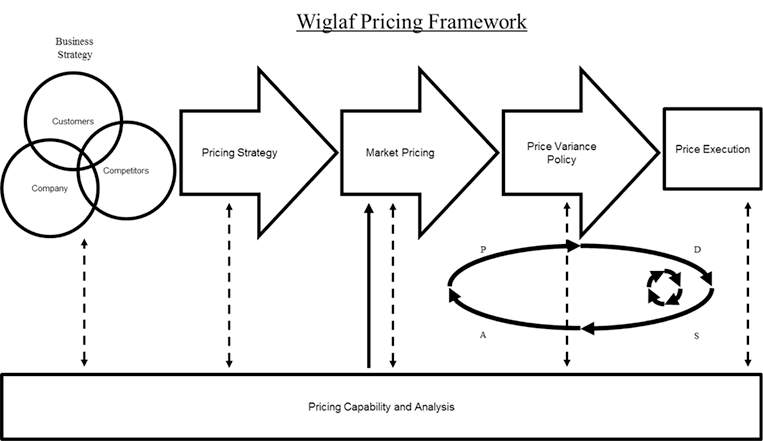
Who should make pricing decisions? Marketing — since pricing is tied to product, placement, and promotional decisions? Sales — since pricing directly impacts customer relationships and sales? Finance — since pricing impacts profits? Well, it’s none of them, all of them, and it depends…all at the same time.
Research has been conducted on how leading firms are getting pricing done right. Common elements of their approach can be found in the Wiglaf Pricing Framework.

Categorizing Pricing Decisions
More often than not, pricing decisions fall into one of two categories; simple or complex.
Simple pricing (ie competitor-based pricing for similar services and products) is largely used by businesses selling commodities. Here, pricing decisions are made incrementally and often in response to competitor behavior such as offering purchase allowances or increasing discounts.
Complex pricing, on the other hand, is driven by originality and what the customer is willing to pay. This type of pricing decision is more reliant on negotiations and is thus more prevalent in consulting services or in the creative industries.
Despite the two broad categories above, day-to-day pricing decisions will vary in scope, along with who is involved with making them.
What Kind of Pricing Decisions Are We Talking About?
To start, research and practice reveals that not all pricing decisions are equal. Some impact how the company engages its entire customer base and competes within its industry, while others affect a single customer in a single transaction. We typically call these the strategic and tactical pricing decisions, respectively, yet even that dichotomy is insufficient.
We can break pricing issues into five key areas, all supported by a pricing capability:
- Business Strategy: how pricing impacts customer, competitive, and corporate strategy.
- Strategic Pricing: price positioning, competitive reactions, price structuring and pricing capability itself.
- Market Pricing: new product pricing and product life cycle management.
- Price Variance Policy: discounting and promotions, sales incentive and the necessary monitoring and analysis of price capture to inform these decisions.
- Price Execution: configuring offers, pricing those offers, quoting those offers to clients and sometimes invoicing, billing and collections management.
Supporting all of these pricing decisions is the capability and analysis embodied in a pricing team, their pricing software, and their access to data.
Who Holds Authority in Pricing Decisions?
From the above list, we see that pricing isn’t just one decision; it encompasses a wide variety of decisions that impact the organization at many different levels. As such, leading firms don’t just leave pricing to one department nor simply let it be concentrated at headquarters. Rather, pricing authority becomes dispersed.
Researchers correlated profits with pricing authority and discovered two key truths:
- Firms that disperse authority horizontally among sales, marketing and finance for the higher-level pricing decisions tend to outperform and be more profitable.
- Firms that disperse authority vertically from the headquarters to the field for the lower-level pricing decisions also tend to outperform.
Hence, pricing decisions aren’t just a matter for marketing, sales or finance. It requires all of them working together. And, it requires getting them to work together across the organization, across borders and across business units. To get it all done and done right, pricing decisions require the support of pricing professionals to accelerate and improve their decision-making skills.
Learn More
Learn more about how leading firms get pricing done right in the “Pricing and Corporate Strategy: The Pricing Decision Framework Proven Successful by the World’s Most Profitable Companies for Getting Pricing Done Right” workshop led by Tim J. Smith, Founder and CEO of Wiglaf Pricing, during the PPS 26th Annual Fall Pricing Workshops & Conference.
